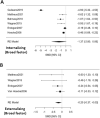Relationship between elimination disorders and internalizing-externalizing problems in children: A systematic review and meta-analysis
- PMID: 37720580
- PMCID: PMC10501701
- DOI: 10.1002/jcv2.12185
Relationship between elimination disorders and internalizing-externalizing problems in children: A systematic review and meta-analysis
Abstract
Background: Elimination disorders are highly prevalent in childhood and often associated with clinically relevant comorbid psychological disorders. The aim of this study is to determine if, and to what extent, children with elimination disorders show higher internalizing and externalizing problems than their healthy peers.
Methods: A multistep literature search was performed from database inception until May 1st, 2022. PRISMA/MOOSE-compliant systematic review (PROSPERO: CRD42022303555) were used to identify studies reporting on internalizing and/or externalizing symptoms in children with an elimination disorder and a healthy control (HC) group. First, a systematic review was provided. Second, where data allowed for it, a quantitative meta-analysis with random effects model was conducted to analyze the differences between the elimination disorder and the HC groups for internalizing and externalizing symptoms. Effect size was standardized mean difference. Meta-regression analyses were conducted to examine the effect of sex, age, and study quality. Funnel plots were used to detect a publication bias. Where found, the trim and fill method was used to correct it.
Results: 36 articles were included, 32 of them reporting on enuresis (n = 3244; mean age = 9.4; SD = 3.4; 43.84% female) and 7 of them on encopresis (n = 214; mean age = 8.6; SD = 2.3; 36.24% female). Children with an elimination disorder presented significantly lower self-concept (ES:0.42; 95%CI [0.08; 9.76]; p = 0.017) and higher symptom scores for thought problems (ES:-0.26; 95%CI: -0.43;-0.09]; p = 0.003), externalizing symptoms (ES: -0.20; 95%CI [-0.37;-0.03]; p = 0.020), attention problems (ES:-0.37; 95%CI [-0.51;-0.22]; p = 0.0001), aggressive behavior (ES:-0.33; 95%CI [-0.62;-0.04]; p = 0.025) and social problems (ES:-0.39; 95%CI [-0.58;-0.21]; p = 0.0001). Significant publication biases were found across several of the studied domains. No significant effect of sex, age or quality of the study score was found.
Conclusions: Children with an elimination disorder may have significant internalizing and externalizing problems, as well as impaired self-concept. It is recommendable to screen for them in children with enuresis or encopresis and provide appropriate interventions.
Keywords: comorbidities; elimination disorder; encopresis; enuresis; externalizing; internalizing; self‐concept.
© 2023 The Authors. JCPP Advances published by John Wiley & Sons Ltd on behalf of Association for Child and Adolescent Mental Health.
Conflict of interest statement
The authors have declared that they have no competing or potential conflicts of interest.
Figures


Similar articles
-
Association of Screen Time With Internalizing and Externalizing Behavior Problems in Children 12 Years or Younger: A Systematic Review and Meta-analysis.JAMA Psychiatry. 2022 May 1;79(5):393-405. doi: 10.1001/jamapsychiatry.2022.0155. JAMA Psychiatry. 2022. PMID: 35293954 Free PMC article.
-
Behaviors of children who are exposed and not exposed to intimate partner violence: an analysis of 330 black, white, and Hispanic children.Pediatrics. 2003 Sep;112(3 Pt 1):e202-7. doi: 10.1542/peds.112.3.e202. Pediatrics. 2003. PMID: 12949313
-
Association of Childhood Externalizing, Internalizing, and Comorbid Symptoms With Long-term Economic and Social Outcomes.JAMA Netw Open. 2023 Jan 3;6(1):e2249568. doi: 10.1001/jamanetworkopen.2022.49568. JAMA Netw Open. 2023. PMID: 36622675 Free PMC article.
-
Internalizing and externalizing symptoms in individuals with neurofibromatosis type 1: a systematic review and meta-analysis.Syst Rev. 2025 Jan 22;14(1):20. doi: 10.1186/s13643-024-02749-0. Syst Rev. 2025. PMID: 39844170 Free PMC article.
-
The Association between Coparenting Behavior and Internalizing/Externalizing Problems of Children and Adolescents: A Meta-Analysis.Int J Environ Res Public Health. 2022 Aug 19;19(16):10346. doi: 10.3390/ijerph191610346. Int J Environ Res Public Health. 2022. PMID: 36011980 Free PMC article. Review.
Cited by
-
Evidence-based child and adolescent mental health care: The role of high-quality and transparently reported evidence synthesis studies.JCPP Adv. 2023 Aug 25;3(3):e12197. doi: 10.1002/jcv2.12197. eCollection 2023 Sep. JCPP Adv. 2023. PMID: 37720582 Free PMC article. No abstract available.
-
Elimination disorders and associated factors among children and adolescents age 5-14 year-old attending paediatric outpatient clinic at Wolaita Sodo University comprehensive specialized hospital, South Ethiopia.Child Adolesc Psychiatry Ment Health. 2024 May 3;18(1):52. doi: 10.1186/s13034-024-00739-7. Child Adolesc Psychiatry Ment Health. 2024. PMID: 38702758 Free PMC article.
-
Telomere Length and Emotional and Behavioral Problems in Children from the Prospective Birth Cohort INfancia y Medio Ambiente (INMA) Study.Children (Basel). 2025 Jul 2;12(7):875. doi: 10.3390/children12070875. Children (Basel). 2025. PMID: 40723068 Free PMC article.
References
-
- Achenbach, T. M. , & Edelbrock, C. S. (1983). Manual for the child behavior checklist and revised child behavior profile. Dep. of Psychiatry.
-
- Achenbach, T. M. Ivanova, M. Y. , Rescorla, L. A. , Turner, L.V., Althoff, R. R.. (2016). Internalizing/externalizing problems: Review and Recommendations for clinical and research applications. Journal of the American Academy of Child & Adolescent Psychiatry, 55(8), 647–656. 10.1016/j.jaac.2016.05.012 - DOI - PubMed
-
- Akça, ÖF. , Aysev, A. , & Aycan, İÖ (2011). Familial features and comorbid psychiatric disorders in children with encopresis. Klinik Psikofarmakoloji Bülteni, 21(4), 345–352. 10.5455/bcp.20110502050441 - DOI
-
- Akyüz, M. , Koca, O. , Karaman, B. , Özcan, Z. Y. , Öztürk, M. İ. , Kutluhan, M. A. , & Karaman, M. İ. (2016). Evaluation of behavioral problems in patients with monosymptomaticnocturnal enuresis: A prospective controlled trial. Turkish Journal of Medical Sciences, 46, 807–811. 10.3906/sag-1502-90 - DOI - PubMed
LinkOut - more resources
Full Text Sources
